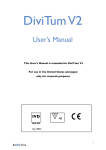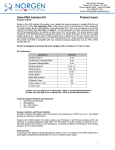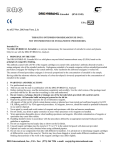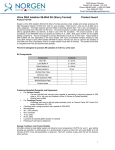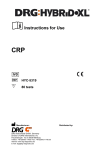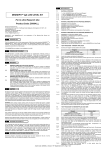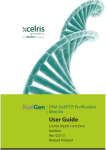Download User`s Manual
Transcript
DiviTum V2 User’s Manual For research use only This User’s Manual is intended for DiviTum V2 only. Contents DIVITUM™ ASSAY FOR MEASURING SERUM THYMIDINE KINASE ACTIVITY 3 INTRODUCTION ....................................................................................................................................................... 3 PRINCIPLE OF THE DIVITUM™ ASSAY ................................................................................................................... 3 ASSAY CHARACTERISTICS........................................................................................................................................ 3 BEFORE STARTING .......................................................................................................... 4 OVERVIEW OF WORKFLOW .................................................................................................................................... 4 SAFETY PRECAUTIONS ............................................................................................................................................. 4 COLLECTING AND STORING SAMPLES ................................................................................................................... 5 EQUIPMENT AND MATERIALS REQUIRED BUT NOT SUPPLIED .............................................................................. 5 CONTENTS OF THE KIT ........................................................................................................................................... 6 STORING AND HANDLING REAGENTS ................................................................................................................... 6 PROCEDURE ....................................................................................................................... 7 CALCULATE TK ACTIVITY ............................................................................................ 9 2 DiviTum™ assay for Measuring Serum Thymidine Kinase Activity Introduction Thymidine kinase (TK) is an enzyme essential in DNA synthesis and thus in cell proliferation. The enzyme converts deoxythymidine to deoxythymidine monophosphate. After further conversions, the thymidine is incorporated into DNA strands. Cells contain two types of TK, but only TK1 has an activity that varies by cell-cycle phase. It is primarily active in the G1-S-phase of cell division. The DiviTum test was developed for analyzing serum samples for TK activity and is only validated for this use. A list of references and more information on thymidine kinase is provided on our website: http://biovica.com. Principle of the DiviTum™ Assay The DiviTum assay is a non-radioactive, high-sensitive test for serum thymidine kinase activity. In the assay, a serum sample is combined with a reaction mixture containing bromodeoxyuridine (BrdU). The TK from the serum phosphorylates the BrdU to its monophosphate. The BrdUmonophosphate is further phosphorylated to triphosphate and is incorporated into a DNA strand that is bound to the microtiter plate. The reagents required for these reactions are included in the reaction mixture. An antibody to bromodeoxyuridine, conjugated to alkaline phosphatase is added to the mixture. The amount of antibody binding the DNA is determined by a color reaction generated by the alkaline phosphatase. High TK activity generates a high optical density on a plate reader. Standards included in the kit are used to generate a standard curve by which the optical density readings from the samples are converted to TK activity expressed as DiviTum Units per liter (Du/L). Assay Characteristics In our reference laboratory, the DiviTum assay has a lower limit of quantitation of 20 Du/L. Recommended working range is from 20 Du/L up to 4000 Du/L or to the plate reader's asserted upper limit of detection if this limit corresponds to a TK activity lower than 4000 Du/L. At 100 Du/L, the assay has a coefficient of variation lower than 20%. The TK activity unit was 3 originally determined with a reference sample of recombinant TK in serum. 1000 Du/L corresponds to the activity that was obtained with 1000ng TK/L. All samples are analyzed in duplicate (2 x 20 µL of each sample is required.). Each kit contains materials for analyzing 40 samples Before Starting Overview of workflow The steps required to perform the assay require less than 8 hours to complete: • Planning the work • Reconstituting components • Diluting samples • Preparing and dispensing the reaction mixture • Distributing diluted specimens to the reaction plate • Incubating • Washing • Adding antibody conjugate solution to the reaction plate • Incubating • Washing • Adding chromogenic substrate solution to the reaction plate • Determining the optical density after 30 and 60 minutes. • Generating the standard curve and calculating the TK-activity of the serum samples. Safety Precautions • Treat all serum samples, materials, and equipment as potentially infectious. Wear protective clothing and gloves. • Some kit reagents contain low concentrations of sodium azide. Avoid contact with skin or mucous membranes. When discarding reagents down the drain, flush the sink with generous amounts of water. • Do not combine components from different DiviTum kits. • Do not use reagents after their expiration dates. 4 • Pipetting and washing must be done carefully to prevent cross-contamination and dilution errors. Collecting and storing samples • Only serum samples are approved for the test. • Blood clots should be removed from samples immediately. • Refrigerate (2 °C to 8 °C) or freeze samples during transportation. • Samples can be refrigerated between 2 °C and 8 °C for up to 3 days before analysis. • Long-term storage of samples requires temperatures below -18 °C. • Frozen sera must be thoroughly agitated after thawing. • Do not use samples that are grossly lipemic or hemolyzed. Equipment and materials required but not supplied • Deionized or distilled water • A tempered incubator (37 °C ± 1 °C) • A plate reader for wavelengths of 405 nm and 630 nm • A plate washer (a washer with an over-flow feature is recommended) • A 20 µL pipette • Several 5 or 10 mL pipettes • A multichannel pipette (8 or 12 channels, volume 10 to 200 µL) • Pipette tips • A bottle for mixing washing fluid with a volume of least 1 L. • Absorbent paper • Anti-foaming agent 5 Contents of the Kit Item Description Packaging Adhesive cover foil Lid for plate Trays Dilution plate (96 wells) Reaction Plate Reaction Buffer REAG A V2 REAG B CONTROL LOW CONTROL HIGH Kit certificate Reaction plate (96 wells) For reagent reconstitution and sample dilution Reagent A (freeze dried) Reagent B (freeze dried) Low control (freeze dried) High control (freeze dried) BUF SUBS Standard sample 1 (freeze dried) Standard sample 2 (freeze dried) Standard sample 3 (freeze dried) Standard sample 4 (freeze dried) Wash Buffer Enzyme conjugate diluent Antibody conjugate (freezedried) Substrate Buffer CONJ ENZ SUBS Substrates for the alkaline phosphatase Standard 1 Standard 2 Standard 3 Standard 4 W ash buffer DIL CONJ ENZ CONJ ENZ V2 Number included Volume 3 1 4 1 aluminum bag plastic bottle 1 1 1 15 mL glass bottle 15 mL glass bottle 4 mL glass bottle 1 1 1 4 mL glass bottle 1 4 mL glass bottle 1 4 mL glass bottle 1 4 mL glass bottle 1 4 mL glass bottle 1 15 mL glass bottle 15 mL glass bottle 15 mL glass bottle 1 1 1 13 mL 12.5 mL 15 mL brown glass bottle pNPP Tablet in blister pack 1 13.5 mL 40 mL 1 Storing and handling reagents • The Kit can be used up to its expiration date if kept frozen at -18° C or lower or up to 2 weeks if kept refrigerated (+2 °C - +8 °C). • Thaw frozen reagents at room temperature and mix all solutions gently but thoroughly before use. • Reconstituted reagents cannot be saved for later use. 6 Procedure Important: the assay must be performed strictly according to this protocol. 1. Plan the work. Select serum samples and prepare your protocol. Samples, controls, and standards are always assayed in duplicate. Always dilute the samples 1:10 when they are first assayed. Samples exceeding the upper limit of the reading range must be reassayed after being diluted an extra 10 times, to a final dilution of 1:100. Four wells on the plate should be set aside as background controls. 2. Thaw the following components: Reag A V2, Reag B, Control Low, Control High, Standards, Reaction Plate and Reaction Buffer. 3. Reconstitute the reagents. • Add 10 mL Reaction Buffer to Reag A V2 and mix gently. • Add 3 mL Reaction Buffer to Reag B and mix gently. • Add 200 µl Reaction Buffer to flasks with the control samples and standard samples. • Put all the bottles on a shaker under mild agitation while performing step 4 and 5 (shake for no less than 20 and no more than 90 minutes). 4. Add Reaction Buffer to the dilution plate. Add 180 µl Reaction Buffer to all the wells to be used. 5. Add samples to the dilution plate. Add 20 µL of serum samples, controls, and standards to the dilution plate according to your protocol. Important: Wash the pipette tip by pumping up and down one extra time in the diluent to remove the entire sample. Be sure to use the same procedure every time. 6. Continue to mix the samples and reaction mixture. Pump the content of the wells in the dilution plate up and down 5 times with a 100µL multichannel pipette. Use a new tip for each sample. 7. Prepare the reaction mixture. Mix the Reag B gently, then add 2 mL Reag B to the Reag A V2 and mix gently. 7 8. Dispense the reaction mixture. With a multichannel pipette, add 100 µL reaction mixture to every well of the reaction plate to be used. Do not forget the wells for background measurements. 9. Add samples to the reaction plate. With a multichannel pipette, transfer 20 µL of each diluted serum sample, control sample, and standard sample from the dilution plate to its designated well in the reaction plate. Adding these samples starts the TK reaction. 10. Incubate the reaction plate Seal the reaction plate with adhesive plastic foil to prevent evaporation. Place on a shaker for 1 minute and then incubate at 37 °C for 180 minutes. 11. Thaw the following components: Wash Buffer, Dil Conj Enz, Conj Enz V2, Buff Subs, and Conj Enz Subs. 12. Prepare the wash buffer. • Dilute Wash Buffer with deionized water to a final volume of 1 L. • To prevent excessive foaming, add the concentrated wash buffer to the bulk of the water first, then mix very thoroughly. The stock solution of the wash buffer is viscous and must be completely mixed before continuing. Add some anti-foam agent to the wash waste bottle to minimize foaming. 13. Reconstitute the antibody conjugate. Add the Dil Conj Enz to the Conj Enz V2. Place on shaker for 20 to 30 minutes. 14. Wash the reaction plate. Wash the reaction plate with wash buffer three times using a plate washer with an overflow feature. • Wash cycle 1: Use a plate washer without overflow, 300µL wash fluid per well. • Wash cycles 2 and 3: Use a plate washer with an overflow, 650µL wash liquid per well and cycle. The flow pressure should be low. 15. If a plate washer with an overflow function is not available, wash for 5 cycles with 300µL per well. After washing, tap the reaction plate 6 to 8 times against absorbent paper to remove the remaining fluid. Let the plate dry upside down on the absorbent paper for 10min. Tap the reaction plate again 6 to 8 times against the paper. 8 16. Start conjugate binding. Add 100µL aliquots of reconstituted Conj Enz V2 to each well in the reaction plate. Cover the reaction plate with adhesive plastic foil. Incubate at 37 °C for 60 ± 10 minutes. 17. Prepare the substrate solution. Add the substrate tablet, Conj Enz Subs, to the Buf Subs bottle. Let it reconstitute for 15 to 30 minutes. Mix gently before use. 18. Wash the reaction plate. After antibody binding incubation, wash the reaction plate as described above. 19. Start the substrate reaction. Add 120µL aliquots of substrate solution to each well. Cover with the lid and incubate at 37 °C in the dark (the substrate is light sensitive) for 30minutes. 20. Measure absorbance. After 30 minutes incubation, measure the absorbance at 405nm using 630nm as reference wavelength. Put the lid back and continue the incubation. Repeat the reading after another 30 minutes incubation at 37 °C. Calculate TK activity Recalculate the measured absorbances for TK activity in Du/L according to the instructions below. • Samples with an optical density that after 30 minutes exceeds the upper limit of the plate reader's linear operating range cannot be evaluated. These samples should be retested, both in normal dilution (1:10) and at 10 times the normal dilution (1:100). • For all remaining wells, subtract the 630-nm absorbance readings from the 405-nm absorbance readings to get Delta OD (many readers do this automatically). • From the four wells dedicated to background (BKG) determination, calculate the mean and standard deviation of Delta OD excluding strongly deviating readings. • Subtract the mean Delta OD of the background (BKG) wells from the Delta OD of all other samples, including the standard and control samples, to get the Delta OD - BKG values for the samples. If a sample has a Delta OD – BKG value less than 0.02 or less than 2 times the standard deviation of the background samples, exclude the sample 9 from further evaluation. The TK activity in these samples is too low to be reliably determined. • On your plate reader or evaluation software, select a log-log program for calculation of the TK-activities of the samples. • Program your plate reader with the standard curve by entering the Delta OD – BKG readings and the TK activity values of the standards. (The TK values of the standards are specified in the kit certificate included in the package). • Using this standard curve calculate the TK activity in the samples in Du/L by comparing their values for Delta OD - BKG to the standard curve. • Calculate the coefficient of variation for each double sample. Samples with a coefficient of variation greater than 20% should be re-assayed. The standard procedure is to calculate TK activity from the OD-readings at 60 minutes. Readings from 30 minutes are used only if 60-minute readings exceed the upper limit of the working range. The upper limit is 4000 dU/L or the physical upper limit of the plate reader when this limit corresponds to a TK activity lower than 4000 dU/L. Samples with a TK activity exceeding the working range should be re-analyzed, both in the standard dilution (1/10) and diluted a further ten times (1/100). 10 Contact Information: Biovica International AB Uppsala, Sweden Phone: + 46 18 44 44 830 Fax: + 46 18 572 428 [email protected] http://biovica.com Art. No: 934 rev RUO. 01 2014-06-27 11











